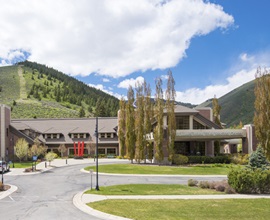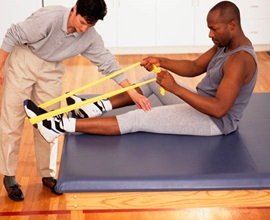St. Luke’s physical therapist embraces his own rehabilitation following surgery

As manager of rehabilitation and a physical therapist for St. Luke’s Wood River, Jesse Foster understands what it takes for a successful recovery after surgery.
Foster, an avid skier, applied his knowledge when he had spinal decompression surgery in August 2017. His hard work paid off, and by mid-December that year he had already logged 10 skiing days at Bald Mountain. He also resumed racing in winter 2018, participating in a masters series and competing across the west in slalom and grand slalom.
“I am skiing better and the pain is gone,” Foster said.
Success was due to a combination of things that included physical therapy before and after surgery, diet and lifestyle modifications and the ability to have rehabilitation close to his home in the Wood River area.
Foster believes numerous years of ski racing contributed to his severe back problems, which increased over time. He gave up other activities that aggravated his pain, including running and heavy weight lifting, but the pain persisted.
“Over the last few years it kept getting worse to the point that when I would be standing at work as a physical therapist my legs would go numb,” Foster said.
After working with a physical therapist and pursuing other options, Foster consulted with surgeons and other experts who all recommended the same procedure, which was performed by Dr. David Verst utilizing a new robotic navigation system at St. Luke’s Wood River.
Foster prepared his body for surgery and recovery by modifying his diet. He gave up ibuprofen (it can slow healing), coffee and alcohol (to improve quality sleep), and added extra calcium to his diet to improve bone healing.
Physical therapy helped him stay strong prior to surgery and helped with his recovery after the procedure. As a patient, Foster learned the value of having such care close to home.
“Rehab before and after surgery are very important,” Foster said. “The fact that we have the services at St. Luke’s Wood River was critical. The time and discomfort of being in the car before or even after surgery would completely prohibit me from going to Twin Falls.”
A big surprise to Foster was that he did not need braces, abdominal binders or anything that would restrict his ability to resume normal movement. He was encouraged to keep moving but cautioned to not lift anything heavy and to avoid irritating swollen muscles. Foster believes the use of the robot had a lot to do with the ability to move and to recover as it enabled Dr. Verst to go in from the side with a minimal incision versus a large one that would disturb a lot of muscle.
Foster came away from the experience with even greater confidence and respect for the care team at St. Luke’s Wood River.
“(The care) from pre-op to discharge could not have been better, offering coordinated and comprehensive care, medical imaging, lab and discharge planning all worked together to provide seamless care,” Foster said.About The Author

Joy Prudek is the manager of public relations for St. Luke's Wood River.


